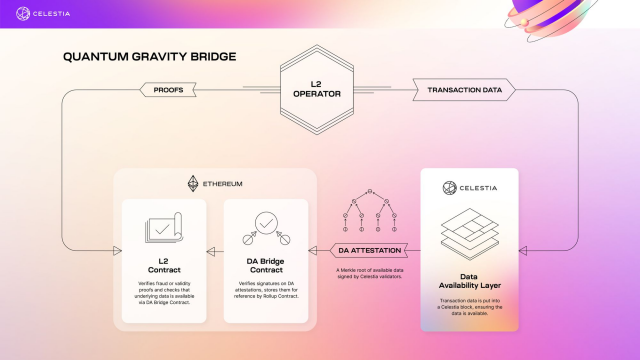
From the rise of DeFi in the summer of 2020, to the outbreak of NFTs in 2021, to the rapid expansion of DAOs today, the demand for block space on Ethereum has exploded. High fees and slow transaction speeds have prompted various teams to develop two types of Layer 2 (L2) solutions, Optimistic Rollups and Zero Knowledge Rollups, in an effort to improve Ethereum's scalability while maintaining decentralization and security. However, as more projects join and transaction volume increases, the fees for rollup solutions will also increase rapidly.
Today, we will focus on how Celestia provides a scalable off-chain data availability (DA) solution for Ethereum rollup teams through Celestiums.
Introducing Celestiums
Celestia is a Layer 1 (L1) blockchain optimized for sorting transaction data and making it available. This makes Celestia a perfect plug-in component for rollup teams to input transaction data with high data throughput.
Currently, Ethereum rollups collect data from multiple transactions into a batch transaction and publish it to Ethereum. This batch transaction includes the aggregated transaction data as calldata, i.e. data that is published to Ethereum but not directly executed. In practice, this can be very expensive due to the cost of publishing all this calldata to Ethereum and Ethereum's limited data capacity.
This is where Celestia and Celestiums come in. Celestium is an Ethereum L2 chain that uses Celestia for data availability but uses Ethereum for settlement and dispute resolution.
As mentioned earlier, Celestia as an L1 does not handle computation and only acts as a data layer. Since resource pricing on Ethereum increases gas fees as block space requirements increase, Celestia has the advantage of being priced only based on bytes rather than computation and storage because it handles the ordering and availability of transaction data. This makes Celestia's data throughput greater than Ethereum.
How Celestiums Work
Celestia's data availability bridge contract, Quantum Gravity Bridge, will be located on Ethereum. Ethereum L2 operators will be able to publish their transaction data to the Celestia network, where it is placed into blocks by Celestia’s Proof of Stake (PoS) validators. This data is then relayed from Celestia to Ethereum in the form of a data availability proof. This proof is a Merkle root of the L2 data signed by Celestia validators, proving the data’s availability.
A deeper look at Celestia’s advantages
Efficient data processing: Celestia focuses on the ordering and availability of data, rather than handling computations. This enables it to provide higher data throughput at a lower cost.
Reduced fees: By publishing calldata to Celestia instead of directly to Ethereum, rollup teams can significantly reduce fees.
Enhanced scalability: Since Celestia is not constrained by Ethereum’s limited data capacity, it can handle large amounts of transaction data, thereby improving the scalability of the entire system.
Celestia’s synergy with Ethereum
As a data availability layer, Celestia forms a strong synergy with Ethereum’s settlement and dispute resolution capabilities. In this way, Celestia not only reduces the burden on Ethereum, but also provides a more efficient and economical data processing path for L2 solutions.
Conclusion: As blockchain technology continues to develop, the issue of data availability is becoming more and more important. Celestia provides an efficient and scalable solution for Ethereum and other blockchain ecosystems through its innovative Celestiums and Quantum Gravity Bridge. By separating data processing and computing, Celestia not only improves the performance of the system, but also reduces the cost for users. This innovative architecture will provide more possibilities for future blockchain applications and developers.
In the future, with the addition of more projects and the continuous advancement of technology, we have reason to believe that Celestia will become an important player in the field of blockchain data availability, bringing more innovation and development to the entire ecosystem.